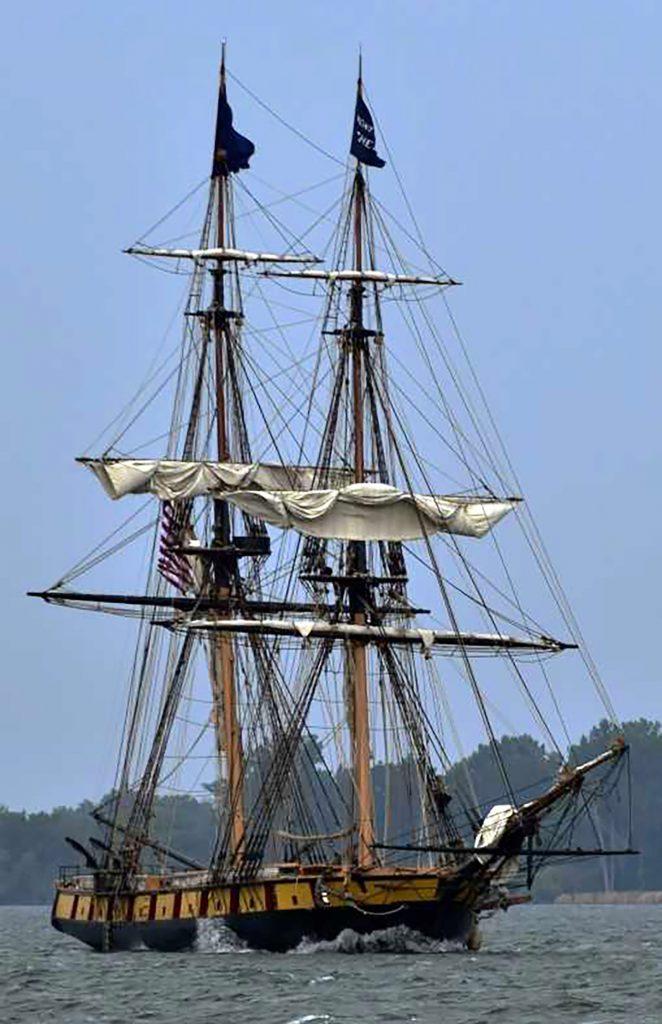The sun was bright, and the sky was blue. The birds sang a melody as a large wooden warship bobbed to their song while it remained tethered to the dock near the Maritime Museum.
The large brown and tan tall ship was none other than the U.S. Brig Niagara, the warship Oliver Hazard Perry commanded and led to a victorious battle on Lake Erie during the War of 1812. According to the U.S. Naval Academy Museum, the original ship sunk in Misery Bay in the 1800s and was uncovered in 1913.
The current brig was built in 1988 to commemorate the 175th anniversary of the Battle of Lake Erie.
The present ship has a shallow pale-yellow frame accented with black trim. In the middle of the ship are two large wooden posts. Each contain at least four gigantic white sails neatly rolled up.
At the top of one post is a blue cloth dancing and twirling in the breeze. It is a navy blue flag that reads in white font “Don’t give up the ship.”
These words were a rallying battle cry uttered by one of Perry’s friends — Capt. James Lawrence. Although this was a rallying cry almost two centuries ago, it seems this phrase is still just as important today.
Displayed throughout the city of Erie are little symbols that remind Erieites of their town’s proud history. For example, State Street displays several pieces of work involving the War of 1812 and the brig. There are large-scale painted murals, flags, vinyl window decals and sculptures of the brig and Perry.
The present ship begins to reveal its character the moment you step aboard. The walls are navy blue with a red border. Leading under the deck is a small staircase that leads to a small room. In the center of the room is a large wooden table and several matching chairs.
Seated on the right side of the table is a man in a gray suit with a pale-yellow shirt. This is Joseph Lengieza, marine operations manager. To Lengieza the ship is more than just living history, it’s an educational tool.
“I think it’s really interesting to juxtapose the historic use of the ship with some of the work we do now,” Lengieza said.
Currently, the brig is used as an environmental science platform and is also being used to help teach kids of all ages discipline and seamanship.
“It is not just this particular moment in time that may be good or not so good,” Lengieza said. “I think that it is very symbolic that we’re using this as an educational platform and mostly looking toward the future. That’s what education is.”
The brig has another meaning to Todd Paropacic, a former Gannon University student.
“To me, it represents the indomitableness of Erie,” Paropacic said. “Erie is in a tough spot right now, but it is a symbol of us not giving up the city.”
Lisa Songer, a marketing coordinator at Professional Development Associates and an adjunct faculty member at Gannon, has a similar conceptualization of the brig.
“The brig to me is a special piece of Erie history we are blessed to have 200 years later,” Songer said. “It is a symbol of what Lake Erie means and how fortunate we are to have had the peninsula and the bay during the war. It is also a symbol of majesty and power.”
This iconic ship has a different meaning to everyone, but several agree on one thing — its role throughout Erie’s past has influenced people’s perceptions of what the brig is symbolically.
“I think in terms of my narrative and Erie’s narrative, Niagara is a symbol of how we are a society,” Lengieza said. “How we are a city that builds things — that makes things. A symbol that we had a 200-year history.”
To this day, the brig continues to serve the Erie community.
By BRITTINY LENE’








